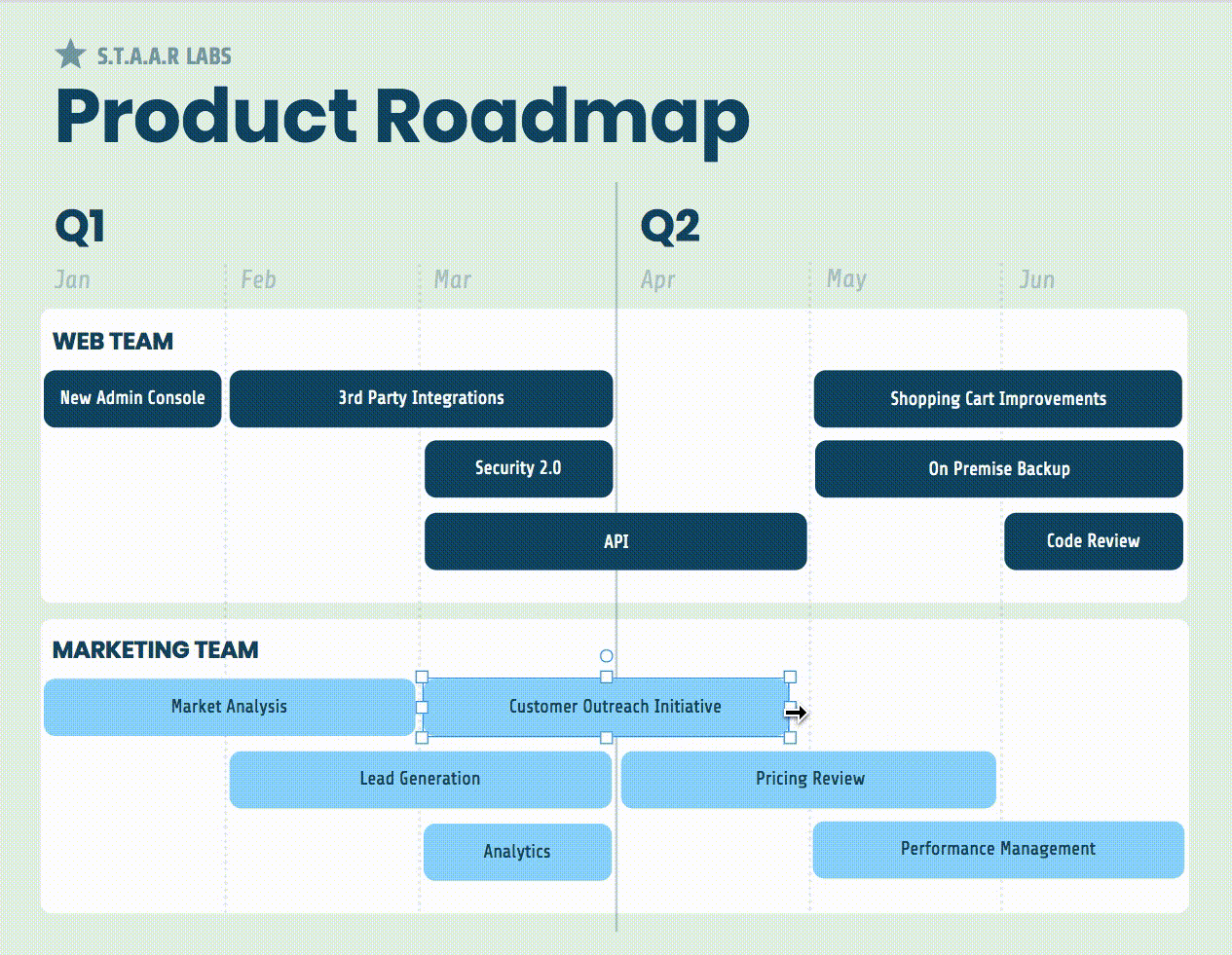Another article about Product Roadmaps? Sure, many product teams may be over this subject, but as a product manager, you need to be prepared to put your customers at the centre of your product (which means you have to think about them all the time!) In the product-oriented era, everything revolves around the customer experience. According to a 2017 report by Nielsen, of around 3,000 new products launched each year, only 15% are truly successful. Not only that, but due to the extreme increase in new products, according to Statista, this 15% has now most likely decreased again. However, we dare to say that this number would be much higher if more product managers did extensive User Research and based their product roadmap on it.
As a product manager, it’s up to you to set the right priorities and make sure you align your product roadmap with your company’s goals. A process that involves identifying opportunities to improve and prioritise your products. But how do you plan your product roadmap without having captured the opinions and expectations of your customers?

A Brief Product Roadmap Summary
Product roadmaps are visual representations that showcase the development of your product. It shows where your product is right now, where you want to go with it, and how you can get there.
The Benefits of a Product Roadmap
- Aids prioritisation of tasks and initiatives
- Progress can be measured and monitored easily
- Creates transparency both internally and externally
- Efficient coordination of tasks and activities between teams and employees
- Helps build an understanding of the entire product cycle
Never worked with product roadmaps? Atlassian offers an easy-to-understand, free product roadmap template.

If you have read this far, we must briefly draw your attention to the challenges and why you should do extensive user research in order to create your roadmaps.
If you want your product team to really benefit from the roadmap, you’ll need to invest a fair amount of time first. It’s no surprise to you as a product manager that prioritising ideas and plans for a new product can be pretty difficult. What will go into your roadmap? Which tasks should be at the top of the list? And which should be put on hold for now? You’ve probably asked yourself these questions already.
Quantitative data like growth metrics and market impact will give you insights into digital trends as a whole, while qualitative data like product feedback will help you maintain a customer-centric approach developing and improving your new product. The sooner you start processing this data on your roadmap, the better you will be. Nevertheless, in order to collect this data, we advise you to conduct extensive user research.
Let’s go into more detail on the subject of roadmaps and user research.
User research as the basis for Product Roadmaps
Continuous user research helps product managers make better product decisions, identify potential functions, and even define attractive test options. Continual research just makes your job as a product manager easier and better. See for yourself!
Even the very best product teams will only be able to guess what customers want from a product based on assumptions. However, with insights from user research, product teams can uncover customer problems, identify the features and functions that are most important to customers, and most importantly, prioritise their product roadmaps accordingly. This customer-centric approach essentially gives you a position for your product that you and your customers will both be satisfied with.
So what are the benefits of User Research for product roadmaps?

Make better decisions. This benefit speaks for itself. When you have a pipeline of user research insights into your roadmap as further input for your prioritisation process (alongside metrics, intuition, strategic direction, competitive landscape, and more), you will make better decisions. This does not mean that you will always make the right decisions, but your decisions have an educated rationale and these are easier to explain to teams and investors.
Discover potential opportunities. Research allows you to learn something new and discover potential opportunities for new features as well as chances for improvement. Maybe it turns out that your pricing structure doesn’t make sense, or that your users find certain features too complicated. With research, the possibilities are endless.
Understand your users / customers better. As a product manager, you probably strive to keep your Voice of the Customer program in mind so that you can make better decisions. With an ongoing approach to research, you can always keep this up. You’ll improve your ability to provide feedback on the UX, text, and any part of the experience that touches the user or customer.
Identify attractive test opportunities. In addition to identifying feature opportunities, continuous user research is ideal for identifying attractive A / B testing opportunities.
As you can see, user research brings some important benefits to your product roadmap. But what types of user research can be used to improve your product roadmap?
- Collect customer feedback online
- Organise customer interviews and learn from your customers
- Analyse support tickets and calls
- Record user sessions and analyse them
In this article, we mainly cover the topic of customer feedback from the area of user research. Want to learn more about it, read on.
How to control your roadmap with user research
So how should you, as a product manager, proceed to really adapt your roadmap to your customers? We recommend that you take different measures for the assorted phases of your product. A product roadmap is not a set of instructions, but a constantly changing reflection of your progress. So employ different methods during the process.
Now let’s look at the different product phases:
The ideation phase
Ideation is the initial phase in which product managers validate goals and absolute must-haves based on customer feedback. Of course, you want to manufacture a product that is also needed by consumers. So it’s about identifying pain points and needs of the potential consumer. Product managers can then focus on what needs to be done to create a Minimum Viable Product (MVP) . How is this accomplished?
Through detailed customer interviews and the asking of open questions, product teams can receive helpful answers to define your product strategy. In this way, you can find out what the customers really need and what their expectations are. These answers will also give you valuable insight into what works and what doesn’t with the product!
The initial development phase
During this phase, product teams get customers to test your product by completing a list of tasks and watching in real time how they work and respond, so you can identify problem areas in your product.
A / B testing is also useful at this stage to compare product versions and evaluate the result based on a single variable.
The ongoing improvement phase
Online customer feedback is crucial in this phase. Here, product teams can track customer satisfaction by tracking positive and negative product and user experiences with, for example, Net Promoter Score (NPS) and CSAT surveys.
So when you’re building a product roadmap, we can safely say that it is absolutely necessary to routinely interact with your customers, respond to customer feedback, and make more data-driven decisions.
In order to go a little deeper into the topic of customer feedback, we have put together the following tips for you:
Set your goals
First, define what you want to learn from your customers. Decide which areas you want to improve and prioritise. These are the first steps you need to take before you can even think about using feedback surveys on your website or mobile app. Do you already have a feedback tool? If not, don’t forget to check out our Most Popular Product Feedback Tools 2021.
Make sure you are collecting the right feedback
Now that you’ve determined what you’d like to achieve with your feedback, it’s time to create your surveys. Depending on your goal for a particular survey, you will need to make a few decisions about how your survey will be delivered and what will be its content. Deployment refers to how (i.e. passive or active surveys) you deliver and where you deliver your surveys on the website. In terms of content, you need to decide which metrics you want to use (Net Promoter Score, CSAT, CES) and any other question types you want to incorporate.
Jobs To Be Done is a great way to uncover needs to make sure you adequately address them on your roadmap. The Jobs to be done framework basically focuses on the wishes and the why of your customers and subordinates the product development.
Survey Content
Our advice is to use a mix of quantitative and qualitative feedback. Quantitative feedback includes metrics (or scores) that you can measure in a dashboard and continuously monitor their progress, while qualitative feedback includes open-ended questions that you can use to measure sentiment and really zoom in on why exactly someone is negative about your product, or service.
Analyse your results and take action
As you may have guessed, collecting feedback is really only part of the process. It is just as important to analyse this feedback data and draw conclusions from it.
Ideally, the analysis phase involves quickly sorting feedback and identifying trends such as causes. Since feedback usually arrives in large numbers, dashboard analyses are particularly helpful in the analysis phase. Dashboards can help users visualise feedback in one place, making it easier to spot trends like an increase in usability on a particular page, a decrease in satisfaction in a particular funnel, and more. There are also technologies like text analytics that allow teams to gain insight into the sentiment behind trending feedback topics and really measure how customers are feeling.

After analysing and gaining knowledge, the next step is to take action. Measures based on feedback not only help build loyalty, but can also lead to more conversions. By leveraging the insights gained through careful analysis, companies can optimize their websites or apps so that their users experience a much smoother journey. To do this properly, it is ideal to have the right action management process that will allow you to engage your “at risk” customers and get them back on track for success.
Continuous Feedback is Essential for Your Roadmap
Let’s be honest. A product roadmap with no customer feedback is a doomed combination. Do yourself a favour and follow the carefully collected advice in this article. And don’t forget: consistency is key. This means you should be collecting customer feedback, all the time!
Ready to see Mopinion in action?
Want to learn more about Mopinion’s all-in-1 user feedback platform? Don’t be shy and take our software for a spin! Do you prefer it a bit more personal? Just book a demo. One of our feedback pro’s will guide you through the software and answer any questions you may have.








